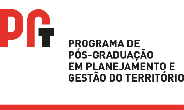Banca de QUALIFICAÇÃO: JÚLIA FERNANDES GUIMARÃES PEREIRA
Uma banca de QUALIFICAÇÃO de DOUTORADO foi cadastrada pelo programa.STUDENT : JÚLIA FERNANDES GUIMARÃES PEREIRA
DATE: 30/01/2024
TIME: 09:00
LOCAL: Videoconferência - https://conferenciaweb.rnp.br/webconf/flavia-9
TITLE:
SOCIO-SPATIAL FRAGMENTATION PATTERNS IN MEDIUM-SIZED CITIES: AN ANALYSIS OF DISPERSION AND SEGREGATION DYNAMICS IN ARAÇATUBA, PRESIDENTE PRUDENTE, AND RIBEIRÃO PRETO
PAGES: 159
BIG AREA: Ciências Sociais Aplicadas
AREA: Planejamento Urbano e Regional
SUBÁREA: Métodos e Técnicas do Planejamento Urbano e Regional
SUMMARY:
This research compares the production of urban space in Araçatuba, Presidente Prudente, and Ribeirão Preto from 2000 to 2022, using quantitative and qualitative approaches on urban dispersion and residential segregation. The study is based on the concept of socio-spatial fragmentation, an intensification of segregation and differentiation in various contexts. This phenomenon encompasses spatial, economic, social, cultural, and political aspects, transcending physical and social separation, resulting in more complex urban forms. A conceptual review was conducted, identifying key characteristics of residential segregation by income and race, as well as urban dispersion, along with methods for quantifying both processes. An observation panel adapted to the Brazilian reality was developed, and related metrics were applied in the studied cities. In the qualitative analysis, the historical, economic, and social formation of the cities was considered, identifying housing spaces and collective facilities. The comparison between cities reveals similar and different processes. The update of the research with 2022 Census data will confirm changes in the center-periphery pattern and the intensification of socio-spatial inequalities, reflecting the fragmentary logic in the production of space.
COMMITTEE MEMBERS:
Presidente - Interno ao Programa - 2064223 - FLAVIA DA FONSECA FEITOSA
Membro Titular - Examinador(a) Externo à Instituição - JOANA BARROS
Membro Titular - Examinador(a) Externo à Instituição - AGNES SILVA DE ARAUJO - PUCPR
Membro Titular - Examinador(a) Externo à Instituição - VITOR KOITI MIYAZAKI - UFU
Membro Titular - Examinador(a) Externo à Instituição - MÁRCIO JOSÉ CATELAN - UNESP
Membro Titular - Examinador(a) Externo à Instituição - EVERALDO SANTOS MELAZZO - UNESP
Membro Suplente - Examinador(a) Interno ao Programa - 3202576 - ANDRE BUONANI PASTI
Membro Suplente - Examinador(a) Externo à Instituição - SÉRGIO HENRIQUE DE OLIVEIRA TEIXEIRA




